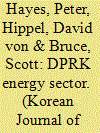|
|
|
Sort Order |
|
|
|
Items / Page
|
|
|
|
|
|
|
| Srl | Item |
| 1 |
ID:
108542


|
|
|
|
|
| Publication |
2011.
|
| Summary/Abstract |
This report discusses the history, current status, and potential future of the DPRK
energy sector. The authors, drawing on the Nautilus Institute's decades of work
on North Korea, describes the history of the DPRK energy sector, in particular
changes in the sector since 1990. The study then looks at the current status and
supply and demand balance of North Korea's energy sector noting the vulnerabilities and critical needs of that sector. The report also explores options for the
rehabilitation of the DPRK energy sector that could be used in negotiations with
North Korea as part of a "roadmap" to denuclearization and legitimate energy
needs if negotiations are not successful and the DPRK either collapses (due to an
internal coup, succession crisis, or war) or continues to stagnate. The report concludes by identifying the robust strategies that are important in both engagement
and non-engagement (collapse or stagnation) scenarios.
|
|
|
|
|
|
|
|
|
|
|
|
|
|
|
|
| 2 |
ID:
110353


|
|
|
|
|
| Publication |
2011.
|
| Summary/Abstract |
The goal of international negotiations with the Democratic People's Republic of Korea (DPRK), when they begin again, will be to convince the DPRK to give up its nuclear weapons and the capabilities to produce them. The DPRK's energy sector is a key to resolution of the issue. Thus offering a well-considered, well-structured package of energy sector assistance options will be key to the sustainable success of the negotiations. This article briefly reviews some of the key options for DPRK energy assistance ranging from human capacity-building in fields like energy efficiency, renewable energy, and energy markets, to assistance with rebuilding key electricity and coal mining infrastructure, to integrated pilot energy/electricity grid/economic development projects on the county level, to light-water nuclear reactors. It then reviews preferences for DPRK assistance options as offered by North Koreans, and a summary of the likely points of view of the key DPRK actors that will be involved in negotiations.
|
|
|
|
|
|
|
|
|
|
|
|
|
|
|
|
| 3 |
ID:
110348


|
|
|
|
|
| Publication |
2011.
|
| Summary/Abstract |
"Energy Security" has typically, to those involved in making energy policy, meant mostly securing access to oil and other fossil fuels. With increasingly global, diverse energy markets, however, and increasingly transnational problems resulting from energy transformation and use, old energy security rationales are less salient, and other issues, including climate change and other environmental, economic, and international considerations are becoming increasingly important. As a consequence, a more comprehensive operating definition of "Energy Security" is needed, along with a workable framework for analysis of which future energy paths or scenarios are likely to yield greater Energy Security in a broader, more comprehensive sense. Work done as a part of the Nautilus Institute's "Pacific Asia Regional Energy Security" (PARES) project developed a broader definition of Energy Security, and described an analytical framework designed to help to compare the energy security characteristics - both positive and negative - of different quantitative energy paths as developed using software tools such as the LEAP (Long-range Energy Alternatives Planning) system.
|
|
|
|
|
|
|
|
|
|
|
|
|
|
|
|
| 4 |
ID:
110360


|
|
|
|
|
| Publication |
2011.
|
| Summary/Abstract |
Economic growth in East Asia has rapidly increased regional energy, and especially, electricity needs. Many of the countries of East Asia have sought or are seeking to diversify their energy sources and bolster their energy supply and/or environmental security by developing nuclear power. Rapid development of nuclear power in East Asia brings with it concerns regarding nuclear weapons proliferation associated with uranium enrichment and spent nuclear fuel management. This article summarizes the development and analysis of four different scenarios of nuclear fuel cycle management in East Asia, including a scenario where each major nuclear power user develops uranium enrichment and reprocessing of spent fuel individually, scenarios featuring cooperation in the full fuel cycle, and a scenario where reprocessing is avoided in favor of dry cask storage of spent fuel. The material inputs and outputs and costs of key fuel cycle elements under each scenario are summarized.
|
|
|
|
|
|
|
|
|
|
|
|
|
|
|
|
| 5 |
|
| 6 |
ID:
110346


|
|
|
|
|
| Publication |
2011.
|
| Summary/Abstract |
The spectacular recent economic growth in the Asia-Pacific region in general, and in many of the economies of Northeast Asia in particular, has spurred a vast expansion in the need for energy services, and an expansion in the demand for the fuels that help to supply these services. Future projections suggest that the growth of fossil fuel use in Northeast Asia, especially in China, will have major consequences for financial and fuel markets and pollution both regionally and globally. Before the project described in this paper was initiated, there was no ongoing forum for energy experts from all of the countries of the region to meet, informally and in an unofficial capacity, to discuss openly and in a targeted fashion the energy situations in their countries, and to work together to evaluate the energy efficiency costs and benefits of different ways of meeting regional demand. The Asian Energy Security (AES) project provides such a forum, and as such constitutes a unique resource in the engagement of the countries of Northeast Asia on the topic of energy security.
|
|
|
|
|
|
|
|
|
|
|
|
|
|
|
|
| 7 |
ID:
110359


|
|
|
|
|
| Publication |
2011.
|
| Summary/Abstract |
Economic growth in the countries of Northeast Asia has spurred a massive increase in the need for energy, especially oil, gas, coal, and electricity. Although the region, taken as a whole, possesses financial, technical, labor, and natural resources sufficient to address much of the region's needs now and into the future, no one country has all of those attributes. As a result, over the past two decades, there has been significant interest in regional proposals that would allow sharing of resources, including infrastructure to develop and transport energy resources from the Russian Far East to South Korea, China, and Japan, and cooperation on energy-efficiency, renewable energy, and the nuclear fuel cycle as well. In this article we review some of these proposals, identify some of the factors that could contribute to the success or failure of infrastructure proposals, and explore some of the implications and ramifications of energy cooperation activities for energy security in the region.
|
|
|
|
|
|
|
|
|
|
|
|
|
|
|
|
| 8 |
ID:
110344


|
|
|
|
|
| Publication |
2011.
|
| Summary/Abstract |
Rapid economic growth in Northeast Asia has vastly increased regional needs for energy services. In several countries of the region, this ongoing growth has been accompanied by significant environmental problems. The countries of the region already constitute the largest import market for liquefied natural gas (LNG). The region has accounted for a progressively larger share of world primary energy use; its share has risen from under 19% in 1999 to over 25% in 2007.
Though the region as a whole possesses resources that could contribute substantially toward its future energy needs, many major energy resources are far from population centers. As such, major infrastructure investments will be required to bring these resources to market. This article provides a description of the current situation of energy demand and supply in Northeast Asia, summarizes recent trends in energy supply and demand, and of the "drivers" that underlie energy use, in the region. Also presented are projections of energy use and of key impacts of energy use, such as greenhouse gas emissions, in the region. Other impacts of continued growth in energy supply and demand in Northeast Asia are reviewed qualitatively.
|
|
|
|
|
|
|
|
|
|
|
|
|
|
|
|
|
|
|
|
|